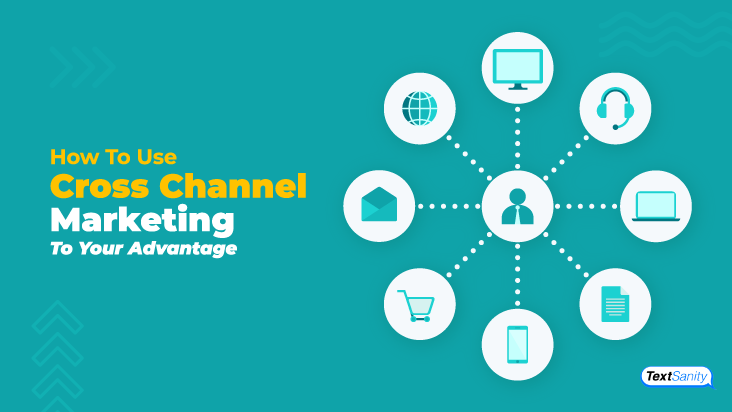How to Use Cross Channel Marketing to Your Advantage

What is cross channel marketing?
Cross-channel marketing is a digital marketing technique used around the world by marketers. It is strategically customer-focused to give consumers a fluid and consistent experience across multiple digital platforms and marketing channels. It has become a powerful marketing strategy and has created a movement in the world of marketing to feed the creation of brand identity for companies.

Implementing a cross-channel marketing strategy is no easy feat. It can be quite intimidating and overwhelming if you don’t approach it correctly. Remember, there are multiple channels to keep up with, and you need to take care of them while simultaneously designing your marketing campaigns. There’s also the matter of analyzing the metrics of your channels. Simply put, it’s a lot.
It may take some time to find the cross-channel marketing strategy that’s right for your company and your audience. When you’re using multiple channels, stay open-minded to the possibilities of adding or pausing channels as it becomes evident that improvements are needed. You can’t afford to be rigid in your approach to marketing in this way.
So, why is it worth it? Why is it important in the first place?

Benefits of cross-channel marketing
Reduced marketing costs
Companies and consumers have a lot in common. Chief among them is saving money. Cross-channel marketing helps companies save money on marketing costs by following the most cost-effective channels for each demographic within their target market.

There are advanced algorithms available to companies that show how likely consumers within a demographic are to make conversions or make purchases in relation to where companies are spending money on marketing costs. The goal is to maximize your ROI (return on investment).
The channels you’re using that are creating the highest ROI will consequently tell you where you’re spending your marketing budget most effectively. For example, if your business is bringing in $2 for every $1 you’re spending on a particular channel, You may want to consider investing in that marketing channel even more.
Using multiple channels will help you see where you should be doing your spending. One particular channel may be bringing in the bulk of your sales, but you can also identify other avenues that are playing a key supportive role to your main platform.
Identifying What Works
Operating within a multi-channel marketing strategy can teach you a lot about the demographics of your consumers. This approach can identify the channels that are most likely to be useful to you.

You may discover that your target audience only uses a few channels. In turn, a standout platform may reveal itself as the most significant in providing you with the most ROI.
Identifying the star doesn’t mean you shouldn’t invest in multi-channel advertising. Different marketing goals will likely need to be addressed through different channels.
An example of identifying what works would be to target a particular age group and discover that SMS marketing was giving you the highest ROI. However, you may find that social media marketing is a good supportive channel to get customers to opt-in to your SMS marketing.
Using both in a layered approach encourages conversion growth, and conversion growth leads to more profitability. Also, different marketing strategies across multiple channels will diversify your marketing strategy and potentially reach different demographics.
Increased Customer Connections
In today’s environment, connecting to your customers is the lifeblood of success. Operating across multiple channels gives you the opportunity to make more connections with your customers. The more consumers engage, interact, and connect with a company or brand, the more likely they are to make a purchase.

Meeting customers on various social media forms a bond and builds trust within them for your brand. It keeps your business on their mind and creates more awareness of your product’s availability. All of this works to increase your credibility and promote brand loyalty.
Using multiple platforms also increases your chances of reaching the right customer at the right time to not only make the sale but make you a part of a customer’s life. When your product and, by extension, your brand becomes part of your customers’ lives, the coveted word of mouth marketing is sure to follow.
Brand Identity And Brand Awareness
One of the first reasons for initiating a marketing campaign in the first place is to increase or create brand awareness. Big-name companies that are known the world over still advertise. Why? It’s not like consumers don’t know what products they offer. Big-name companies still advertise to remind consumers that they exist or increase awareness and inform consumers of expected changes.

By being on multiple channels, you inevitably increase your brand awareness. Even in a market that’s heavily saturated, if you can get your brand’s names in enough corners of the digital marketing world, you can notch out a place for your business and your products. This also helps to improve your business’s reputation and brand credibility.
Multiple channels of marketing allow you to improve your brand identity and give it a depth of character. Brand identity is essential to modern marketing. Consumers don’t just buy into products any more. They buy into the brands themselves.
Think about the last commercial you saw. Often commercials show very little of the actual product. Instead, brands offer a glimpse of a lifestyle that appeals to their target audience. Why does this work?
Remember that creating connections creates customers. When your company understands the lifestyle and goals of your target audience, consumers feel seen and heard. They relate their values and ideas to a brand’s values and ideas. The brand develops into more than a company, and the genuine connection the customers feel drives brand loyalty and increases brand awareness.
Viewing these connections on the platforms they prefer also tells the customer that your brand really understands them and where they like to spend their time.

Implementing A Cross-Channel Marketing Strategy
1. Create opportunities for social listening. Often, customers just want to be heard. Providing feedback opportunities to consumers where they feel engaged and heard promotes lasting connections with customers.

2. Use complementary mediums. Some things just go better together. Like ketchup and mustard or peanut butter and chocolate. Marketing mediums are no exception. Incorporating complementary mediums gives fluidity to your campaigns. Customers experience these various campaigns seamlessly. Examples of complementary mediums:
-
In-store signage + Mobile
-
Social media + Video
-
Video + PPC
-
Email + Mobile
-
TV + Computer
3. Analyze your metrics. Establishing your key performance indicators among multiple channels will help you track, identify, and analyze your metric data. As with all your goals with business and business component strategies, you need measurable results. Cross-channel marketing is no exception.
4. Invest in customer support. Like social listening suggests, your customers want to have the opportunity to interact with you. They want to form two-way communication. For customers to feel heard, customer support with a quick reply time is crucial.
When most communication in life is just a text away with almost instant results, customers expect the same from their brands. It’s up to businesses to recognize this need and rise to meet it.
5. Test your techniques. Testing marketing campaigns using control groups is an important factor in determining if a channel is working or your product is just selling itself. Creating a control group is not marketing through a campaign to a group of users.
You may want to consider using a control group that’s not targeted by any of your cross-channel marketing to evaluate the overall effectiveness.
It’s also important to test your techniques out on yourself. It’s a common rule of thumb that you don’t serve food that you haven’t tasted. The same can be said for marketing channels that you haven’t been exposed to.
For example, if you’re implementing a text marketing campaign, send the text to yourself. Click the links, check it for readability, and look at it through different cell phone types. See what your customer sees.
6. Keep it fluid. The most effective cross-channel marketing takes consumers through various channels without disruption or differing messages and experiences.
The fluid movement of cross-channel campaigns provides a natural feel for your brand’s messaging, and it starts to give your brand its own feel. Reliability across platforms builds trust, and trust improves credibility.
Summary
Using cross-channel marketing data metrics can help you make continuous improvements to keep your strategy increasingly providing real results. Cross-channel marketing is a sophisticated strategy, and it takes commitment.
That commitment is worth it when you are looking to reach your customers, create brand awareness, improve sales, and generate leads within new market segments. Cross-channel marketing will help you achieve all of your marketing goals.
Remain mindful that your content across all platforms aligns seamlessly with each other to create that smooth and fluid transition for your audience. Test your strategies, adjust as you go, and don’t be afraid to add or pause channels for effectiveness.


